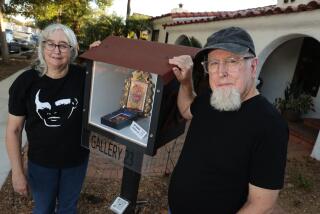Dallas Museum of Art drops admission fee
This is news, even though it shouldn’t be: Today, the Dallas Museum of Art announced that it is eliminating its $10 general admission fee, effective Jan. 21. After that, a visit to the museum’s permanent collection galleries will be free.
It’s news because it’s man-bites-dog. Not only do most art museums charge for the privilege of looking at the paintings, sculptures and other art installed in their publicly subsidized galleries, but announcements about the practice are usually pegged to raising the cost, not getting rid of it.
And it shouldn’t be news because general admission to every art museum ought to be free already. I’ve written about this before (the most recent example is here). But going to an art museum, whether the Los Angeles County Museum of Art or the Museum of Fine Arts, Boston, or any other in between, should not be compared to the expense of going to the movies. Instead, it should be like going to a public library: Free and open to all.
Dallas Museum Director Maxwell Anderson, who arrived in Texas last year, seems eager to replicate a success at his prior institution, the Indianapolis Museum of Art, where he was director from 2006 through 2010. After he resumed a free general admission policy there, attendance more than doubled.
And isn’t that what museum directors always say they want -- more visitors, especially to their permanent collections? The spectacle is not uncommon of a line at the box office for a putatively “special” exhibition featuring less significant art than what is already on view in lightly traveled permanent collection galleries.
Zero admission could happen today, but the two-month lead time gives the DMA an opportunity to gear up its community for the transformation. Dropping a museum’s admission fee is not a move to be taken lightly. Changing the nature of the regular visitor’s art experience -- deepening it -- requires imagination and hard work.
Fundamentally, it means expanding the museum’s membership. The usual method for that is pretty degraded: Program the museum with lightweight entertainments to appeal to audiences with no interest in art, and then offer discounted admission to new members who otherwise wouldn’t dream of dropping 10 bucks -- or $40, $60 or more if the whole family comes along -- to see a beautiful 10th century Indian sandstone carving of Vishnu or a fine 1919 Cubist still life by Picasso in the permanent collection.
Hucksterism is the common term for the usual member’s discount, with art regarded as P.T. Barnum’s Fiji mermaid and visitors urged to step right this way to check out the egress. The gambit mostly creates churn: An attendance surge is followed by a drop, until the next high calorie/low nutrition program juices the numbers again.
Instead of this self-defeating -- and expensive -- scheme, the DMA plans to do what other museums offering free admission have done: Expand the philanthropic pool. DMA members will be called partners, and the entire local community will become a prospective association of micro-philanthropists. Regular members, not just rich benefactors and wealthy local businesses, are made into active stakeholders in the institution.
And younger people and students, who are always sentimentally extolled as “our future” and then often ignored, will have a visually provocative place to hang out.
Museums, Anderson told the Dallas Morning News in August, are “a charity. We need support, and we need it from affluent patrons, foundations, corporations and government agencies. That is the quadrant I work in.” Starting now, the quadrant includes all of Dallas.
The DMA announcement bucks the privatizing wave that grabbed the United States by the throat more than 30 years ago, a grim development that might finally be petering out in a generational shift. Art museums rapidly lost their distinctive status as civic educational institutions and began to be seen as revenue-producing sites for cultural tourism. Failures litter the landscape.
Art museums were certainly not ideal back then, but privatizing public spaces has hardly been an improvement. Good for the DMA for joining the handful of other institutions, from Baltimore to Minneapolis, that are trying to reset the dial.
ALSO:
Art review: A flowering in Florence at the Getty
Art review: The West Coast debut of a Mike Kelley sculpture
Art review: ‘Bodies and Shadows’ shows Caravaggio’s influence
More to Read
The biggest entertainment stories
Get our big stories about Hollywood, film, television, music, arts, culture and more right in your inbox as soon as they publish.
You may occasionally receive promotional content from the Los Angeles Times.











